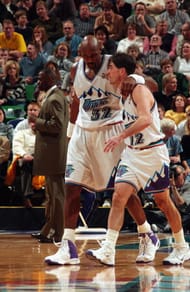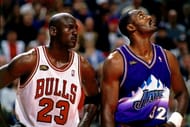At his enshrinement into the Naismith Hall-of-Fame in 2010, a proud Karl Malone, who graced the dais with his childhood hero, New York Knicks legend Willis Reed, thanked everyone for giving a shy kid from Louisville an opportunity to come this far.
As is custom with such august occasions, he made a few jokes, recalled some nostalgic memories, thanked his family, coach and teammates, and paid reverence to all the transcendent legends that made the Promised Land worthwhile.
In the regal company of dignitaries like John Stockton, Larry Bird, Magic Johnson, Charles Barkley and Jerry Sloan, he summed it up beautifully: “I hope I did it the way my peers did it before me. I didn’t do anything but try to play hard. I didn’t have a motive, because it wasn’t about me. It was never about me. It is about a lot of other people.”
Explore the NBA Draft 2024 with our free NBA Mock Draft Simulator & be the GM of your favorite NBA team.
And as he tried to carefully acknowledge everyone who mattered in his life, I couldn’t help but feel in awe of the man, almost apologetically acknowledging a player, who never got the recognition and the adulation he truly deserved.
Maybe the smaller fan base of Salt Lake played a factor. Maybe the fact that he was closest to dethroning Michael Jordan was another. Maybe his outrageously open-mouthed refusal to play with Magic Johnson after he had gone public with his HIV infection got him some more haters. And if these weren’t reasons enough, there were still some people who hated him for his physicality and nasty fouls on Isiah Thomas and Steve Nash.
Malone was the anti-superstar. He was not your poster boy or your white-collared polished player. He didn’t drive luxury cars but chose to ride a truck or a bike instead. Neither did he spend his days off holidaying in exotic locations; he was happier fishing on the bank or out hunting in the forests.
Malone didn’t care much about fashion either, as he strutted about wearing his signature cowboy hats and shoes. The hard-nosed man, he spoke his heart out unapologetically without any sense or regard for diplomacy, and was by no means anything close to the flash of a Jordan or a Barkley. He didn’t play for a city like Los Angeles (not in his prime at least) or a New York. To many, he was just the dark horse running a race, that nobody wanted him to feature in.
However, Malone did run the race, and ran it being himself, rather than adhering to the media’s definition of a star. And to defy all those who didn’t want him to get the distance, he worked that much more.
If there was anything that Malone prided himself on, it was the discipline and the effort that he undertook to prepare himself for each and every game. It was this work-ethic that saw him clock 18 seasons for the Jazz, while missing only SIX games due to illness or injury.
Malone’s work-ethic remained unmatched. Standing at 6’9” and 265 pounds, he was quick enough to run the floor with the quickest of guards, adroit enough to finish plays on the break, and strong enough to beat players on the post. He had a complete repertoire of moves, ranging from a fade-away jumper to a hook-shot. And quite like Bill Laimbeer, he played bigger than his size and would do anything to impose himself physically on the game.
If Malone felt like he needed to, he wouldn’t mind swinging the wild elbow, or getting in the face of opponents. He did it to the likes of David Robinson, Thomas, Tim Duncan and many more. To the fans, he dirty. To himself, he was just being bigger and imposing his will, as he famously stated, “Forget the technique. Hit the guy across from you. Don’t let somebody come in your space.”

Pow-Pow: The greatest two-punch the NBA has ever seen: Karl Malone #32 and John Stockton #12. (Getty Images)
Malone’s biggest strength was his discipline and his work-ethic, lessons that he had imbibed from his difficult childhood in Summerfield, Louisiana. He was the youngest of nine kids, raised by his mother, who worked multiple shifts to provide for the family.
Now, Summerfield wasn’t a land of multiple opportunities. It was a small town inhabited by farmers and country folks, with a single school, a single store and a tightly knit community, where almost everyone knew everybody. To the silent country neighbourhood, there was a single passion that reflected in almost every single driveway in the town: their love for basketball.
However, the Malone’s weren’t rich enough to even afford the sport. They didn’t have the funds to have a card-board hung over a pole and the first basketball that Karl was gifted was actually purchased on a per-day instalment. When Karl had the ball, his mother would stand with her arms crossed in the shape of a ring and he would spend hours shooting hoops into her arms.
Malone, however, took naturally to the sport and quickly rose to become a high-school star, leading the school team to three Class C State Championships. It wasn’t long before Louisiana State came calling.
Malone’s exploits in Louisiana made him a prospective top draw in the 1985 NBA draft. It was even reported that he was so sure that the Dallas Mavericks would draft him eight that he had already rented an apartment in Dallas. The Mavs, however, passed on him and as destiny would have it, the Jazz landed Malone with the 13th pick. Talk about 13 being unlucky!
Malone’s rookie year was a definite eye-opener for many teams in the league as he showcased a rare mix of athleticism, stamina and the desire to run the floor that was still unexplored territory for the league’s big men.
Before Malone hit the court running, big men were stereotyped as players who needed to get the rebounds, make the easy buckets and protect the rim. Malone gave the power forward position a new dimension with his ability to run the floor and score easy points off the fast-break. Add to that his indomitable strength and basketball intelligence, and he already looked like a star in the making.
But for all his athleticism, Malone still lacked the offensive touch and the post-moves that made players like Kareem Abdul-Jabbar and Wilt Chamberlain great. It was then that Coach Frank Layden decided to tweak Malone’s style; something that would have a great impact on his career.
Layden knew that Malone wasn’t the type to shy away from hard work and he knew it was imperative that he got the required direction. Layden laid the foundations for Malone to turn from the all-energy player into the efficient low-post scorer.
Malone worked hard on his game as he improved his shooting percentage from a lowly 46% to the high-fifties. He also became a much improved free-throw shooter. The foundation was set and when John Stockton and Sloan (talking over from Layden) joined the bandwagon, the Jazz seemed destined for greatness.
Stockton and Malone made quite possibly the greatest one-two punch in the league and their famed pick-and-roll game had rival defences bamboozled. Stockton’s intelligence combined with the overwhelming repertoire that Malone had, led Utah from a struggling franchise to championship contenders in the West.
But despite putting up great regular season performances, the Jazz failed to get it done in the business end of the season, faltering to the Phoenix Suns and the Houston Rockets on numerous occasions.

So close yet so far: Michael Jordan #23 of the Chicago Bulls matches up against Karl Malone #32 of the Utah Jazz in Game Three of the 1998 NBA Finals at the United Center on June 5, 1998 in Chicago, Illinois. The Jazz lost consecutive finals to the Bulls (1997 and 1998). (Getty Images)
Despite trade opportunities, a frustrated Malone stuck to the Jazz in hope that they could manage to find a final piece that would lead them to a NBA Championship. The team had all the championship intangibles: a demanding and unrelenting coach that pushed his players to the hilt, a floor general that ran the offense like Mozart playing his symphony, and Malone, who was quite possibly the best low-post force in the game. All they were missing was a shooting guard and in came Jeff Hornacek. In Byron Russell, they got some muscle and perimeter defence.
The pieces seemed to all come together in the 1996-97 season. The Jazz went on to record a 64-18 season, with Malone averaging 27.4 PPG and 10 RPG. Malone was awarded the regular season MVP title and the buoyant Jazz team crushed all competition to make it to the NBA Finals.
The Finals were to be the first of the epic duels between the Chicago Bulls and the Jazz. The Bulls took a 2-0 lead, helped by the erroneous shooting performance of Malone and Jordan’s scoring abilities.
The tide turned in Game 3 and 4 when Malone struck back with 37 points and 24 points respectively, highlighted by the spectacular game-winning full-court assist that Stockton threw to him. The Bulls won Game 5 and with Game 6 on the line, Malone had the chance to tie it with two crucial free-throws. However, the Mailman, as he was famously known, failed to deliver and bricked both the clutch free-throws.
Next year the two teams again matched up in the Finals and this time Malone and company seemed eager to vindicate the previous season’s loss. Malone had a difficult time contending with Dennis Rodman and Scottie Pippen but still managed to fight his way through an average of 24 PPG and a match-winning 39 point Game 5 performance to keep the Jazz in the series.
Game 6 was pretty much the same story with Malone going for 31 points, and the Jazz dominating the Bulls for most parts of the game. The series seemed destined for a Game 7 when with 18.4 seconds left, Jordan delivered the greatest Finals moment of his career.
Jordan stole the ball off Malone’s hands and then executed the much famed cross-over on Russell and sank the 20-footer to give the Bulls their sixth ring. It was as if Jordan stole the ring off Malone; the closest the Mailman ever got to a ring.
Malone ended his career as a two-time NBA MVP, a two-time NBA All-Star MVP, an 11-time NBA First Team selection and quite possibly the second best Power Forward to ever play the game (after Tim Duncan); 36.928 points (second best after Kareem), 14,968 rebounds (sixth best in NBA history) and many great memories.
However, beyond the stats and the numbers Malone will always be remembered as an uber-competitve athlete, a work-horse and an overtly sensitive man. He took all his criticism with insane amount of seriousness and his sensitivity towards the same turned out to be his greatest motivation and driving force. A great example of the same is when AC Green was chosen ahead of Malone as a starter in the 1990 NBA All-Star Game. The very next day, Malone dropped 61 against the Milwaukee Bucks and Green.
It was his way of earning respect and proving his points. Such tireless crusades in many ways define the life and career of Malone. Summed up beautifully by the man himself, “Sometimes you follow your dreams. I say to the young, If you have a dream, chase it.”
For more articles in this series, click here: NBA’s top 10 players of the 90s.
Utah Jazz Fan? Check out the latest Utah Jazz depth chart, schedule, and roster updates all in one place!
